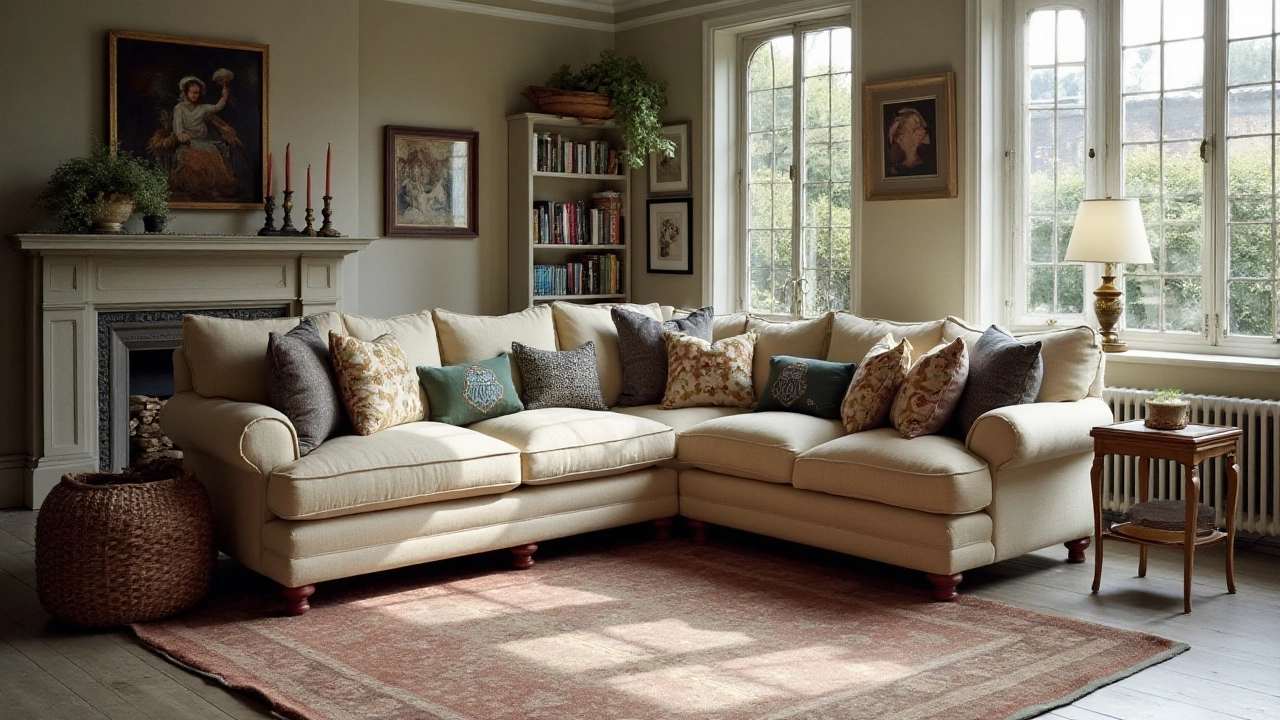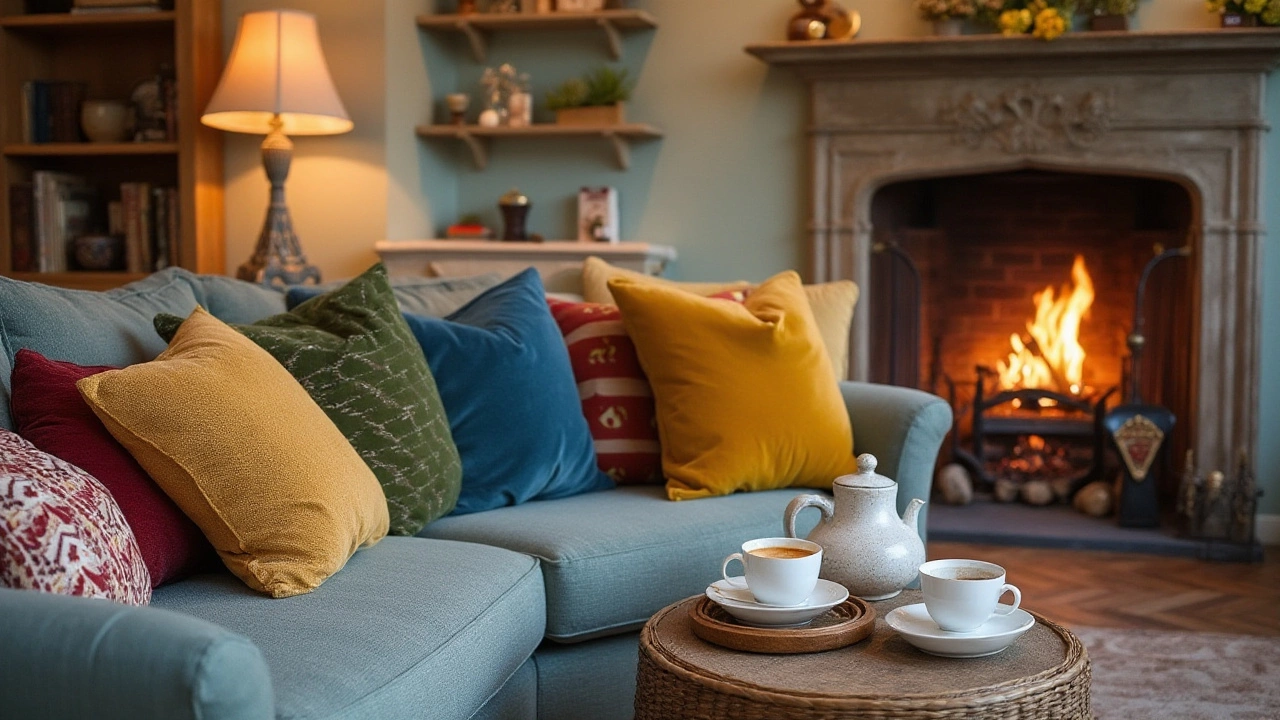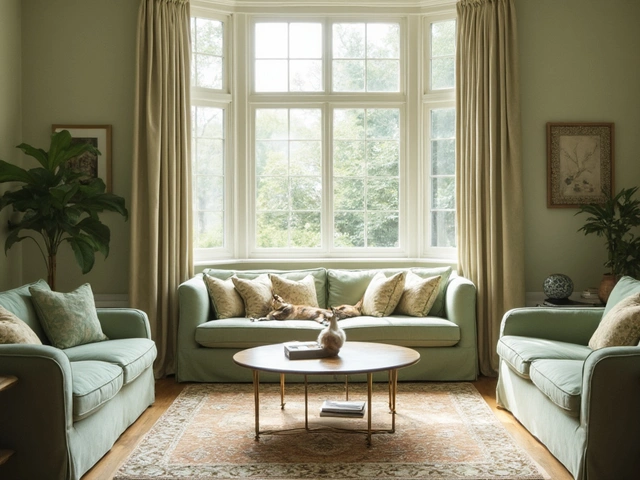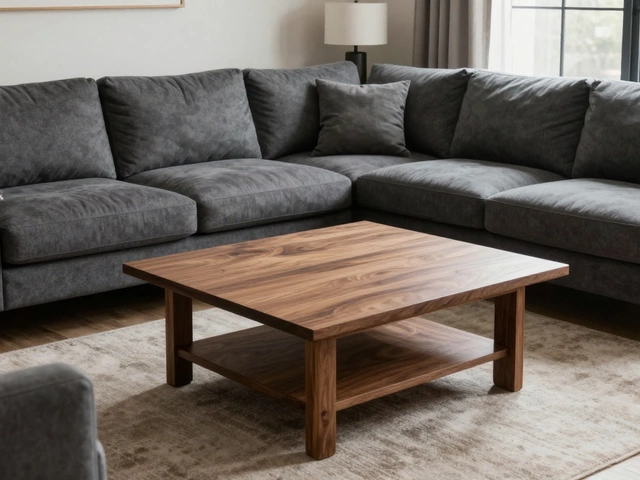A corner sofa stands as a statement piece in any living room, offering ample seating and a canvas for your creativity. But achieving the perfect look and feel with cushions requires more than just tossing them on the couch. It's about thoughtful arrangement and selecting the right textures and colors that complement your home decor.
Cushions can bring life to a neutral sofa or tone down a brighter piece, serving as a bridge between style and comfort. With the right approach, you'll not only enhance the aesthetics of your space but also create a welcoming environment for relaxation and conversation.
- Understanding Your Corner Sofa
- Choosing the Right Cushions
- Balancing Colors and Textures
- Strategic Cushion Placement
- Cushion Arrangements for Different Occasions
- Maintaining and Caring for Your Cushions
Understanding Your Corner Sofa
The corner sofa is more than just a piece of furniture; it's a versatile piece that can redefine your living space. Its design, often tailored to fit snugly in a room's corner, maximizes seating while minimizing its footprint, making it an ideal choice for both large and small spaces. These sofas come in varied layouts, from L-shaped to U-shaped designs, each offering different advantages. The layout you choose can dictate the flow and functionality of your room, providing a comfortable spot for family gatherings or a cozy retreat for quiet moments.
When selecting a corner sofa, consider the size and shape of your space. An L-shaped sofa, usually characterized by a long sectional with a shorter perpendicular piece, works well in rooms with unfocused seating areas. On the other hand, U-shaped sofas, which feature two equal sections branching from a central piece, effectively create a natural gathering point, perfect for larger spaces and families. A well-chosen corner sofa can also serve as a room divider, subtly delineating different areas in an open-plan setting. As the legendary interior designer Elsie de Wolfe once said, "A house should be a joy to live in." This type of sofa can certainly help facilitate that sentiment.
The aesthetics of your corner sofa are largely determined by its material. Leather offers a timeless appeal, fostering a sophisticated and polished look, while fabric options provide versatility in texture and color, enhancing comfort. Whether opting for modern minimalism or a more ornate style, there is a match to be found. Consider too, how the sofa's upholstery can work with or against other elements of your decor, influencing the mood and feel of your room. For instance, neutral tones can provide a calming backdrop, whilst bolder hues make a strong statement.
Comfort is paramount. The depth and height of the seating should align with your family's needs. Deep-seated sofas are ideal for lounging, while a slightly shallower seat can offer easier access for formal settings. Pay attention to the cushioning; down-filled options may offer plush comfort, but firmer foams provide better support and longevity. Investing in a corner sofa is not just an aesthetic choice but a functional one, impacting how you use and enjoy your living space daily. How you style it with cushions can further enhance these features, blending style and practicality effortlessly.
Choosing the Right Cushions
Choosing the right cushions for your corner sofa can transform your seating area into a stunning focal point in your living room, but it requires thoughtful consideration of several elements. First, consider the dimensions of your sofa and the room it occupies. The size of the cushions should be proportional to the sofa size to ensure that they do not overwhelm or get lost against the furniture. For instance, a large sectional corner sofa might benefit from a mix of large and medium-sized cushions, creating a layered and plush look without overcrowding the space.
Fabric choice is another crucial aspect when selecting cushions. The texture of the cushion cover not only adds visual interest but also influences the comfort level. Velvet cushions, for instance, offer a luxurious feel and can add elegance and warmth to the room. On the other hand, linen or cotton covers might suit a more casual or minimalist style. The durability of materials is equally important, particularly in households with children or pets, where stain-resistant fabrics can be a practical choice. According to interior designer Emily Henderson, "When choosing cushions, always think about your lifestyle and pick textures that can stand up to everyday use but still look stylish."
Next, the color scheme plays a vital role in enhancing your home decor. Start by evaluating the existing colors in your living space, including walls, curtains, and other furnishings. Cushions can be used to introduce pops of color to a neutral room or to tie various elements together in a bolder decor. A harmonious color palette can evoke a sense of balance and unity, while contrasting shades can create a dynamic and lively atmosphere. Employing the 60-30-10 rule, where 60% of the room is the dominant color, 30% the secondary color, and 10% an accent shade can be a good guide.
The number of cushions can vary depending on personal preference and the aesthetics you wish to achieve. A minimalist approach might involve just a few strategically placed cushions, while a more eclectic style could include an array of cushions in varying sizes and shapes. Experimentation is key, and don’t be afraid to rearrange until the look and feel are just right. Mixing different shapes, such as square, rectangular, and round cushions, can also add depth and interest to the arrangement.
For those who enjoy seasonal decor changes, cushions offer an easy way to refresh the space without a major overhaul. During colder months, opt for cozy textures and warmer colors to create a snug retreat, while lighter fabrics and brighter hues can invigorate the room as spring and summer roll around. With cushions, adaptability is the name of the game, allowing you to keep your living area stylish and inviting year-round.
If you like to align your living space with current design trends, note that sustainably sourced fabrics and patterns inspired by nature are gaining popularity. Incorporating eco-friendly materials not only contributes to a greener planet but also enhances the natural beauty of your home. In conclusion, choosing the right cushions is about blending functionality with aesthetics, ensuring your home decor feels both cohesive and expressive.

Balancing Colors and Textures
When it comes to elevating the visual appeal of your corner sofa, balancing colors and textures is the secret sauce to success. The art of managing these elements can transform a mundane seating area into a vibrant focal point. Start by considering the room's existing color palette. Are you working with a neutral scheme that craves a pop of color, or perhaps a bold space that needs calming tones for balance? A cornerstone to the strategy is the color wheel, a tool that helps you harmonize hues by pairing complementary or analogous shades. This harmony ensures that your cushions don't clash but rather enhance the overall aesthetic. Textures, on the other hand, add a tactile element that is equally important. They invite guests to engage not just with their eyes, but also with their sense of touch, creating an inviting atmosphere.
Incorporating a mix of textured cushions can make your home decor feel dynamic and layered. Think about the visual and physical textures: linen brings a light, airy feel; velvet exudes luxury; knitted fabrics add warmth and coziness. The goal here is to avoid a monotonous appearance. An expert tip is to choose three main textures and distribute them across the sofa using different pillow sizes and shapes. This kind of variation draws attention and breaks up the visual landscape. Combining textures with the right colors can highlight personal tastes and show off an inventive style. It's essential, however, to not overdo it—too many contrasting elements can be overwhelming and cause sensory overload.
Let’s not forget the role of patterns in this equation. Patterns can be a wonderful way to integrate color and texture, but they should be used thoughtfully. Bold patterns can serve as accent pieces among solid colors, creating a point of interest without dominating the room. For those feeling adventurous, mixing patterns can be exciting. The key is to keep a common theme or color within the patterns to create a cohesive look. If you decide to venture into patterns, bear in mind the scale of the prints. Larger patterns work better on larger cushions or covers, while smaller prints can provide subtle elegance. Remember, the ultimate aim is to achieve a balance that feels both curated and relaxed.
"To achieve a balanced look where colors and textures complement, not compete, think of layering cushions as you would layer your wardrobe for the season." – Interior Design MagazineIn some cases, adding a unifying element such as a throw blanket can seamlessly tie together the colors and textures of your cushion arrangement. Throws that contrast or complement the cushion selection can act as the finishing touch, pulling the entire corner sofa design together with grace. A well-placed throw can also add an additional layer of comfort and style.
Strategic Cushion Placement
When it comes to place cushions on a corner sofa, consider both function and form. A sofa's function is to be comfortable, yet it can also serve as an artistic space where you express your style. Starting with the back row, larger cushions usually form a sturdy base, creating both a physical and visual support. The base of larger cushions should span the corner, tapering down towards each armrest. Using this cascading pattern not only boosts comfort but also draws the eye across the sofa, making the seating area appear larger and more inviting.
Introduce medium-sized cushions in front of these to add depth and softness. They should harmonize with the large counterparts in terms of color and pattern, forming a bridge between the background large cushions and the smaller, decorative options you'll bring in later. The use of textures can start to become prominent here. Think velvets against linen or quilted surfaces beside plain weaves, which don't only feel luxurious under the hand but break visual monotony.
The final layer of cushion arrangement often involves smaller cushions that sit at the forefront. These cushions can vary greatly in shape, from round to rectangular. They act as the accent pieces, offering pops of color or intriguing patterns that catch the eye. These are also the pieces you might swap out seasonally or according to mood. A simple switch of these smaller cushions can refresh the entire room's vibe without changing the underlying structure.
If you’re someone who likes experimenting with different looks, keep a rotation of seasonal covers. This way, your corner sofa becomes more than just a place to sit—it turns into an evolving showcase of personal style. 'The right mix of textures and patterns in cushion placements can significantly alter the ambiance of the room,' argues interior designer Tim Gosling.
"Cushions are like the jewelry to a sofa. They can be serious disruptors of the decor equation or they can elegantly tie it all together," says Gosling.Using cushions this way turns your corner sofa into a dynamic centerpiece easily tailored to specific occasions, enhancing the livability and elegance of your living space.

Cushion Arrangements for Different Occasions
Transforming your corner sofa to match the occasion can bring an element of surprise and delight to your living space. Whether you're hosting an elegant dinner party or enjoying a laid-back movie night, the way you arrange your cushions can make a substantial difference. For a cozy, intimate gathering, consider leaning towards a softer, more uniform color palette. Opt for earthy tones or shades that evoke warmth to create a soothing atmosphere.
In contrast, an energetic social event is the perfect opportunity to showcase your creativity and experiment with vibrant colors and diverse patterns. Arrange the cushions asymmetrically to give your sofa a dynamic feel, using brightly colored or geometrically patterned pillows that catch the eye. By balancing bold hues with neutral ones, you maintain a visual harmony without overwhelming the senses. As interior designer Jane Lockhart says,
"The key to any great design is finding the right balance between form and function."
A change in season offers another ideal scenario for refreshing your living room ambiance. During the festive winter months, incorporate deep reds, greens, and golds, or cushions with holiday motifs for a cheerful and inviting space. Arrange them in layers with varying sizes to add depth and texture, which can also enhance the comfort level. Use darker, plush fabrics that not only provide warmth but also align with the season's spirit. A summer look might entail breezier fabric choices like linen, with marine blues or sandy beiges that bring a cool, airy vibe to your room.
For a family movie night, prioritize comfort while keeping aesthetics in mind. Arrange large, plump cushions in a way that maximizes relaxation, mixing them with throws to add an extra layer of coziness. Let the cushions function as informal seating for a casual gathering, making the space more flexible and accommodating. The versatility of your corner sofa lies in its ability to adapt to various uses, guided by the clever assembly and disassembly of your cushions.
To maintain a sense of style while being adaptable to numerous scenarios, invest in cushions with removable covers. This not only facilitates effortless changes in aesthetic but is practical for cleaning. The ease of swapping covers allows for seasonal updates or event-specific themes without compromising the integrity of your decor. Consider seasonal storage for out-of-use cushion covers to ensure they remain in good condition. A simple rule of thumb: utilize storage baskets or shelves to keep your options organized and at your fingertips whenever a new occasion arises.
Maintaining and Caring for Your Cushions
Keeping your cushions looking fresh and vibrant on your corner sofa requires a bit of routine care and attention. While these plush accents can add comfort and style to any seating arrangment, they are also magnets for dust, pet hair, and occasional spills. To maintain their appeal, it’s essential to adopt a regular cleaning schedule. Start by vacuuming your cushions weekly with the upholstery attachment to remove dust and debris. For those who share their homes with pets, this task might need to happen more frequently. Using a lint roller can also quickly swipe away hair and prevent it from embedding into the fabric fibers. Regular airing out, preferably on a sunny day, can help freshen them up by eliminating any trapped odors.
Spot cleaning is your first line of defense against sudden stains. Always tackle spills immediately before they become stubborn marks. Blot the area with a clean cloth or paper towel instead of rubbing, which can spread the stain. Depending on the fabric, a mild detergent mixed with water can be effective for cleaning. It's worth noting that for more delicate materials, dry cleaning might be the safest option. As a rule of thumb, always test any cleaning solution on an inconspicuous area first to ensure it won’t cause discoloration or damage. "Prevention is better than cure," says interior expert Marie Claire in a recent article emphasizing the importance of swift action against stains.
Protective sprays are an unsung hero for cushion care. They can add a water and stain-resistant layer over your cushion fabric, especially on materials prone to fading or staining. Look for eco-friendly sprays that are free from harmful chemicals to maintain the fabric's integrity. The application process is straightforward: spray evenly on clean cushions and allow them to dry thoroughly before usage. For cushions with removable covers, machine washing them according to care labels can extend their life span significantly. However, avoid excessive heat during drying to prevent shrinkage.
Rotating and fluffing your cushions are simple yet effective strategies to keep them looking full and evenly worn. By doing this frequently, you prevent areas of the cushion from becoming too compressed by equalizing wear across its surface. If your cushions look saggy, a quick fluffing session—simply grabbing and shaking them lightly—can restore their shape and plumpness. For feather-filled options, knead the cushions while rotating them to redistribute the fill evenly. You can also swap cushions from different seats for balanced wear.
Consider investing in high-quality cushion inserts if the existing ones have flattened beyond repair. Look for foam or feather combinations to achieve that perfect balance between firmness and softness. These inserts not only add volume but can instantly refresh the feel of your seating arrangement. Occasionally, it’s worth splurging on professional cleaning, especially for irreplaceable or luxury fabrics. They lend a meticulous touch that ensures thorough cleaning without the risk of damage.
By incorporating these strategies into your home care routine, you'll extend the lifespan and appearance of your corner sofa cushions remarkably. The time and effort spent on maintaining them are a worthwhile investment for preserving the charm and coziness they bring into your living room environment.





